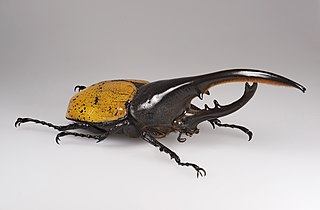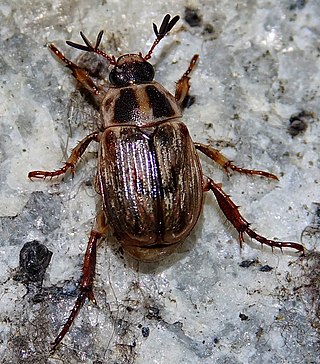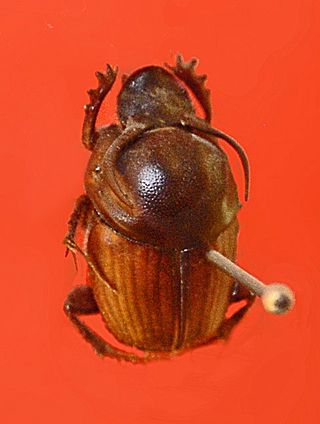
Beetles are insects that form the order Coleoptera, in the superorder Holometabola. Their front pair of wings are hardened into wing-cases, elytra, distinguishing them from most other insects. The Coleoptera, with about 400,000 described species, is the largest of all orders, constituting almost 40% of described insects and 25% of all known animal species; new species are discovered frequently, with estimates suggesting that there are between 0.9 and 2.1 million total species. Found in almost every habitat except the sea and the polar regions, they interact with their ecosystems in several ways: beetles often feed on plants and fungi, break down animal and plant debris, and eat other invertebrates. Some species are serious agricultural pests, such as the Colorado potato beetle, while others such as Coccinellidae eat aphids, scale insects, thrips, and other plant-sucking insects that damage crops. Some others also have unique characteristics, such as the common eastern firefly, which uses a light-emitting organ for mating and communication purposes

In biology, a weapon is a specialized physical trait that is used by animals to compete with other individuals for resources. Most commonly, the term refers to structures that males use to fight other males off for access to mates. They can also be used to defend resources in intraspecific competition, or to ward off predators. Examples of weapons include horns and antlers, both among the most recognizable weapons, though even within those categories, the structure of the specific weaponry is often unique to the species, with a wide variety of designs observed across many genera.

Mealworms are the larval form of the yellow mealworm beetle, Tenebrio molitor, a species of darkling beetle.

The Hercules beetle is a species of rhinoceros beetle native to the rainforests of southern Mexico, Central America, South America, and the Lesser Antilles. It is the longest extant species of beetle in the world, and is also one of the largest flying insects in the world.

Dynastinae or rhinoceros beetles are a subfamily of the scarab beetle family (Scarabaeidae). Other common names – some for particular groups of rhinoceros beetles – include Hercules beetles, unicorn beetles or horn beetles. Over 1,500 species and 225 genera of rhinoceros beetles are known.

Dynastes tityus, the eastern Hercules beetle, is a species of rhinoceros beetle native to the Eastern United States. The adult's elytra are green, gray or tan, with black markings, and the whole animal, including the male's horns, may reach 60 mm (2.4 in) in length. The larvae feed on decaying wood from various trees.

Phanaeus vindex, also known as a rainbow scarab, is a North American species of true dung beetle in the family Scarabaeidae. It is found in eastern and central United States and northern Mexico. It is the most widespread species of Phanaeus in the United States and it has a wide habitat tolerance. It may hybridize with the generally less common P. difformis.

Anomala orientalis, also known as the oriental beetle (OB), is a species of Rutelinae in the family Scarabaeidae. It is a beetle about 0.7 - 1.1 cm long, with mottled, metallic brown- and black-colored elytra and a similarly colored thorax and head during the adult stage. It is sometimes confused with the larger and more colorful Japanese beetle. During the larval stage, the oriental beetle can be identified by the parallel line raster pattern.

The Atlas beetle is a very large species of beetle in the family Scarabaeidae, found in Southeast Asia. Males have three prominent horns. The species is named for Atlas, the giant of Greek mythology who supported the skies.

The elephant beetle is a member of the family Scarabaeidae and the subfamily Dynastinae. Elephant beetles are Neotropical rhinoceros beetles.

Cotinis nitida, commonly known as the green June beetle, June bug or June beetle, is a beetle of the family Scarabaeidae. It is found in the eastern United States and Canada, where it is most abundant in the South. It is sometimes confused with the related southwestern species figeater beetle Cotinis mutabilis, which is less destructive.

Actaeon beetle is a rhinoceros beetle of the family Scarabaeidae.

Xylotrupes gideon, the brown rhinoceros beetle, is a species of large scarab beetle belonging to the subfamily Dynastinae.

Bolitotherus cornutus is a North American species of darkling beetle known as the horned fungus beetle or forked fungus beetle. All of its life stages are associated with the fruiting bodies of a wood-decaying shelf fungus, commonly Ganoderma applanatum, Ganoderma tsugae, and Ganoderma lucidum.

Onthophagus taurus, the taurus scarab, is a species of dung beetle in the genus Onthophagus and the family Scarabaeidae. Also known as the bull-headed dung beetle, it is a species that specializes in cattle dung and is widely utilized to maintain clean pastures, making it agriculturally valuable. These beetles are typically 8–10 millimetres (0.31–0.39 in) in size. The males of this species exhibit distinct characteristics: large “major” males possess long, sweeping, curved horns resembling those of a longhorn bull, while small “minor” males have tiny horns that project upward from the back of their heads. Females, on the other hand, lack horns. These small beetles are oval shaped, the color is usually black or reddish brown. Sometimes the pronotum has a weak metallic sheen.

The Moellenkampi beetle, is one of four large species of rhinoceros beetles from Southeast Asia belonging to the genus Chalcosoma. The Moellenkampi beetles belong to the beetle family Scarabaeidae along with other rhinoceros beetles. They are characterized by having two large, forward-projecting horns on the pronotum or thorax, and another large, forward and upward-projecting horn on the head. They also have a distinct metallic lustre, which is the reason behind their genus name, which derives from Greek, chalko-, and is the combining form of chalkós, meaning copper.

Euoniticellus intermedius is a species of dung beetle in the family Scarabaeidae. E. intermedius is native to Southeastern Africa but has spread to the United States, Mexico, and Australia. E. intermedius acts as an important agricultural agent due to its improvement of soil quality and removal of parasitic pests.
Alkalihalobacillus trypoxylicola is a bacterium from the genus of Alkalihalobacillus which has been isolated from the gut of a larva beetle.

Gnatocerus cornutus, or the broadhorned flour beetle, is a common species of beetle in the Tenebrionidae family. It is distributed worldwide and is commonly found in warm, tropical regions, preferring grains, yeasts, and flours as its main diet. The total development time is about 47 days. G. cornutus is predominately found in mills as a storage pest and has a wide distribution.

The white worm beetle is a species of beetle in the family Scarabaeidae. It is the only species in the genus Hylamorpha. This beetle is native to South America, particularly in regions of Argentina, Brazil, and Uruguay.


























